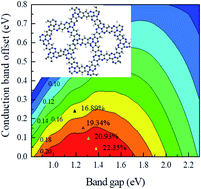A two-dimensional quinazoline based covalent organic framework with a suitable direct gap and superior optical absorption for photovoltaic applications†
Abstract
Great efforts have been made in exploring two-dimensional (2D) semiconductors with appropriate band gaps and high optical absorption for their great potential applications in solar cells. Here, by using density-functional theory calculations, we predicted a quinazoline based covalent organic framework (Q-COF), which has been synthesized recently (O. Buyukcakir, et al., Angew. Chem., Int. Ed., 2019, 58, 872–876), as an excellent 2D photovoltaic material. We reveal that a Q-COF monolayer, which can be exfoliated feasibly from its layered bulk, possesses a desired direct band-gap of 1.18 eV, and exhibits promising optical absorption (105 cm−1) in the visible and near-infrared light region. Moreover, we found that Q-COF and ZnSe monolayers could form a heterojunction with a type-II band alignment, using which a photoelectric conversion efficiency (PCE) of 16.89% can be reached. Under strain engineering, the band gap and the band offset of the Q-COF/ZnSe heterojunction can be effectively tuned, and the PCE can be further improved to 22.32%. Our results would motivate more experimental and theoretical research to further explore the potential applications of the Q-COF monolayer in optoelectronic devices, especially in solar cells.



 Please wait while we load your content...
Please wait while we load your content...